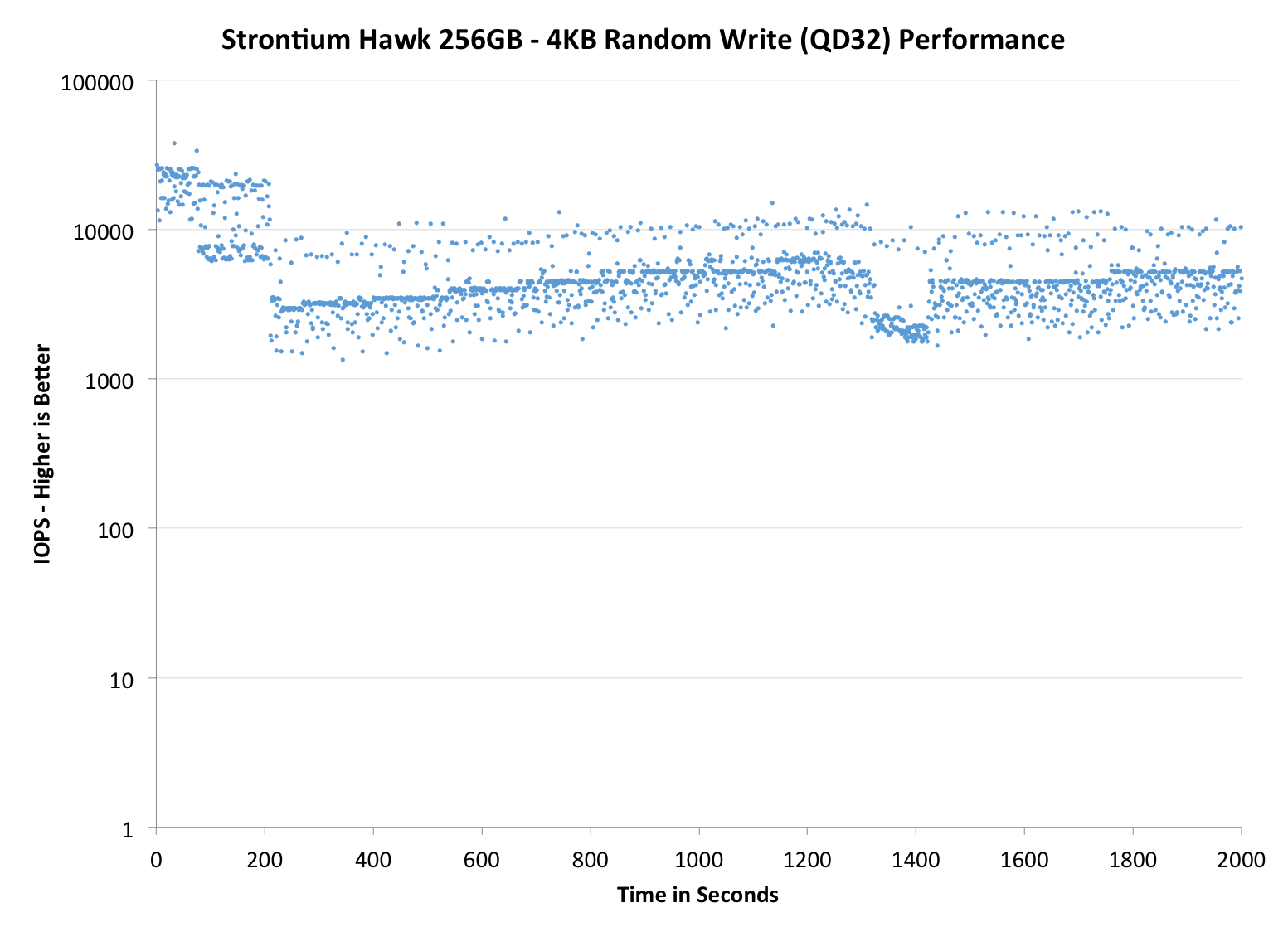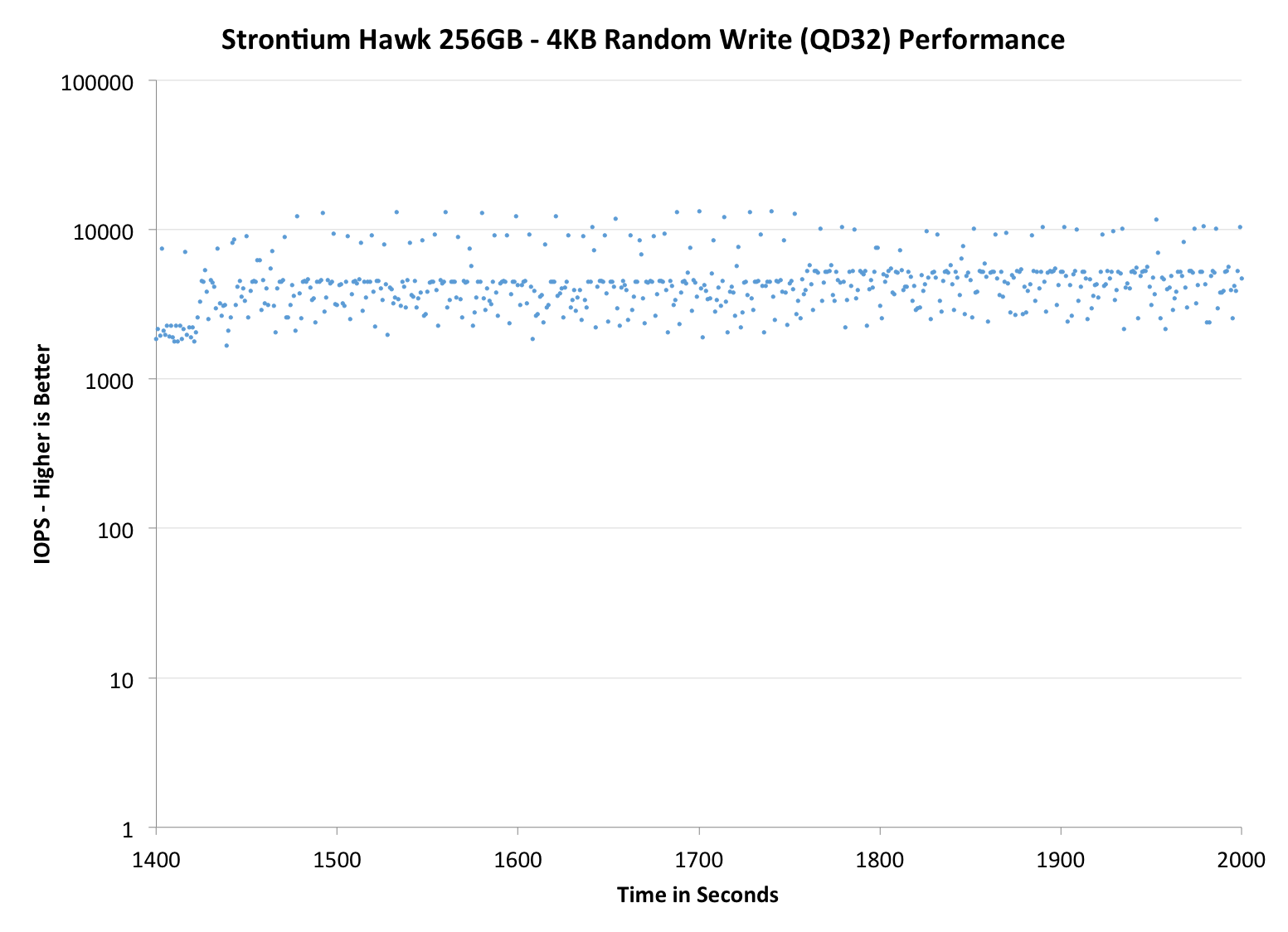Strontium Hawk (240GB) Review
by Kristian Vättö on June 25, 2013 8:00 AM ESTPerformance Consistency
In our Intel SSD DC S3700 review Anand introduced a new method of characterizing performance: looking at the latency of individual operations over time. The S3700 promised a level of performance consistency that was unmatched in the industry, and as a result needed some additional testing to show that. The reason we don't have consistent IO latency with SSDs is because inevitably all controllers have to do some amount of defragmentation or garbage collection in order to continue operating at high speeds. When and how an SSD decides to run its defrag and cleanup routines directly impacts the user experience. Frequent (borderline aggressive) cleanup generally results in more stable performance, while delaying that can result in higher peak performance at the expense of much lower worst case performance. The graphs below tell us a lot about the architecture of these SSDs and how they handle internal defragmentation.
To generate the data below I took a freshly secure erased SSD and filled it with sequential data. This ensures that all user accessible LBAs have data associated with them. Next I kicked off a 4KB random write workload across all LBAs at a queue depth of 32 using incompressible data. I ran the test for just over half an hour, no where near what we run our steady state tests for but enough to give me a good look at drive behavior once all spare area filled up.
I recorded instantaneous IOPS every second for the duration of the test. I then plotted IOPS vs. time and generated the scatter plots below. Each set of graphs features the same scale. The first two sets use a log scale for easy comparison, while the last set of graphs uses a linear scale that tops out at 40K IOPS for better visualization of differences between drives.
The high level testing methodology remains unchanged from our S3700 review. Unlike in previous reviews however, I did vary the percentage of the drive that I filled/tested depending on the amount of spare area I was trying to simulate. The buttons are labeled with the advertised user capacity had the SSD vendor decided to use that specific amount of spare area. If you want to replicate this on your own all you need to do is create a partition smaller than the total capacity of the drive and leave the remaining space unused to simulate a larger amount of spare area. The partitioning step isn't absolutely necessary in every case but it's an easy way to make sure you never exceed your allocated spare area. It's a good idea to do this from the start (e.g. secure erase, partition, then install Windows), but if you are working backwards you can always create the spare area partition, format it to TRIM it, then delete the partition. Finally, this method of creating spare area works on the drives we've tested here but not all controllers may behave the same way.
The first set of graphs shows the performance data over the entire 2000 second test period. In these charts you'll notice an early period of very high performance followed by a sharp dropoff. What you're seeing in that case is the drive allocating new blocks from its spare area, then eventually using up all free blocks and having to perform a read-modify-write for all subsequent writes (write amplification goes up, performance goes down).
The second set of graphs zooms in to the beginning of steady state operation for the drive (t=1400s). The third set also looks at the beginning of steady state operation but on a linear performance scale. Click the buttons below each graph to switch source data.
 |
|||||||||
| Strontium Hawk 256GB | Corsair Neutron 240GB | Crucial M500 960GB | Samsung SSD 840 Pro 256GB | SanDisk Extreme II 480GB | |||||
| Default | |||||||||
| 25% Spare Area | |||||||||
Performance consistency isn't very good. It's not horrible but compared to the best consumer drives, it leaves a lot to be desired. Fortunately there are no major dips in performance as the IOPS is over 1000 in all of our data points, so users shouldn't experience any significant slowdowns. Increasing the over-provisioning definitely helps but the IOPS is still not very consistent: It's going between 10K and ~2K IOPS, while for desirable drives the graph is very linear with low amplitude.
 |
|||||||||
| Strontium Hawk 256GB | Corsair Neutron 240GB | Crucial M500 960GB | Samsung SSD 840 Pro 256GB | SanDisk Extreme II 480GB | |||||
| Default | |||||||||
| 25% Spare Area |
|
||||||||
 |
|||||||||
| Strontium Hawk 256GB | Corsair Neutron 240GB | Crucial M500 960GB | Samsung SSD 840 Pro 256GB | SanDisk Extreme II 480GB | |||||
| Default | |||||||||
| 25% Spare Area | |||||||||










26 Comments
View All Comments
Kristian Vättö - Tuesday, June 25, 2013 - link
That's different. Apple doesn't hide the fact that they've updated the iPad, the least they do is release a press release. I agree that calling third-gen iPad the "iPad 3" and then going back to just "iPad" wasn't the best move from Apple, but it was understandable as the naming would quickly get stupid (imagine e.g. iPad 11). Apple has always been doing that with the MacBook Pros for instance.Strontium did nothing to let the public know that they've changed suppliers, hence the suspicion. No press release, no mention in the product page, nothing. Like I said in the article, we are the first to report about this - I even thought I'm reviewing a SandForce drive until I took the drive apart.
gamoniac - Tuesday, June 25, 2013 - link
Great review. Not a bad drive at all. Unfortunately it is overshadowed by the GB vs GiB and Hawk vs Python issues. I don't mind owning one if reliability is their focus. Now the other deciding factors are warranty and customer service. If they can build up a good reputation, they will have a good following.toytanks - Wednesday, June 26, 2013 - link
I just purchased a the Samsung 840 Pro 256GB. Does anyone know how much of a difference it would make to use this instead, in terms of battery life?LB-ID - Wednesday, June 26, 2013 - link
Absolutely not, and you're a fool soon parted from your money if you do.zjozjom - Wednesday, June 26, 2013 - link
for all you thinking samsung 840 pro the best drive, getting brain washed only to see the destroyer benchmark owns it =(yeahhh look at the inconsistent write for sandisk extreme II under hd tach yet it destroys samsung 840 pro due to ncache LOL gj sandisk, samsung stop brain wash people thanks, people stop being retards thanks yeah
hemlock44 - Thursday, June 27, 2013 - link
Should they ever plan to sell in Italy, I strongly suggest a name change, because "Strontium" recalls a scatological term here :-)